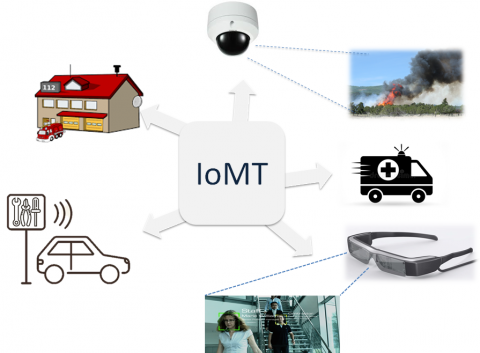
by Philip Merrill
Media Things are new connected objects that can be searched, discovered and composited by inanimate analytical agents operating on the Internet of Things. By making media files/streams a "Thing," established IoT tasks such as the smart home can be better supported while many new use cases are enabled. There is more to this than knowing what kind of video file is dealing with, as well as knowing information about its content, such as capture-time and location. MPEG's many standards envision wide-ranging applications. Media Things on the IoT can provide a means to gather together and associate the wealth of data online into coherent information packages, usable by device systems, and supporting applications that are representative of MPEG's wide range.
These Media-Thing associations are clumped by inanimate agents, and one can presume this is eventually for presentation to a human user, as represented by IoMT's many possible use cases. Media Things can be searched, discovered and used within the pre-existing Internet of Things framework either by API or within a blockchain framework, for security or commerce for example. The promise of the Internet of Things, to begin with, is based on the activity of devices-as-agents engaging in increasingly useful activities online. Thought of in terms of a smart home, human users are now presented with home-on-an-app-dashboard for many of their devices, such as remote-control coffee machines, alarm systems, nanny-supervision systems, and lighting. Surveillance networks and capabilities have also been influential, in part because of evolving systems to manage production processes, not just dedicated apps for theft-prevention. Audio and video are two forms of sensor data, but datatypes are extensible. Sensors range from environmental modeling devices to medical implants. So IoMT is bringing more than just Media Things to the IoT party. IoMT also introduces the broad range of ways other MPEG standards can be put to good use across the evolving range of device-systems.
The Internet of Things emphasizes connectivity and trust. MPEG has more commonly posed its use cases in terms of human users, but IoT is a bit device-centric. It envisions a distributed network of devices, following the model of a smart home. Today's smart speakers can add natural language, but again the most common emphasis is on what a human user can do, while in control of their home's equipment. At the level of IoT inanimate users, it is a convenience to imagine the user's control systems as a device. Device as user, for the purposes of smart-agent work such as searching and generating lists of recommendations. Such device-systems can be wearable, mobile or even implanted. Smart devices for many use cases are likely to integrate several systems. The data interchange to make the whole thing work does not need to recognize these equipment designs the way a human would. Smart glasses, wearable sensor outfits or heart implants, able to be adjusted by remote control over the internet, rely on well formed data such as descriptive metadata. A host of useful descriptions are accessible in Media Things because the many varieties of MPEG integrate over a generation of work in many areas that now readily work together and can be further integrated in turn for new tasks. The Internet of Media Things makes searchable MPEG information available, for wide-ranging file-types and applications, to devices on the Internet of Things.
For those familiar with MPEG applications in general, the sort of smart IoMT behavior envisioned includes the video-rich world outside of the home, with accompanying audio or more as desired and provided for. While driving, IoMT helps support adjustments such as brightness when headlamps are first turned on, informed by road-condition sensors, or audio system adjustment to balance the audible mix with road or engine sounds inside the cabin. In a factory, many systems in use now provide ready access to manuals. Augmented-reality integrations can supplement recommendations, based on video-image object recognition. Whether in a museum or a mall, details can be made available over the Internet of Things and MPEG Media Things to support advanced integrations. A blind or deaf person could take advantage of smart city information to better orient themselves during travel. Potentially, a party authorized to supervise someone while traveling could take advantage of multiple systems of street cameras, managing the hand-off to cameras in ever changing locations.
Another relevant application is crowd videography of important real-time events. With present search capabilities, time and location sorting can yield a sense of being there when news breaks out. Compositing and featuring select real-time crowd-coverage for live events is part of our world now, notably for sports, concerts and other entertainment. Beyond public spaces becoming more smart, the period of time during a special event can be monitored as multiple systems, users and devices record it.
Emergency uses can include remote control of implants by a doctor while a patient is in the ambulance approaching the hospital. Firefighters can learn about a blaze they are driving toward and conference insights in real time for short- or long-term measures. Since necessity is the mother of invention, it is likely this area will lead to innovations during actual emergencies.
Some of MPEG's confidence that it has a relevant role to play in the Internet of Media Things, is because the world is capturing and transmitting increasing amounts of video. This enormous, growing data warehouse can be searched, including by big data and AI approaches. IoT is outside of MPEG and so the IoMT needs to fit in or be adjusted to fit with IoT tech-specs. Hence the IoMT standard enables the IoT to be increasingly MPEG-ified. It will be used based on how and when people need their media, which increasingly seems to be all the time, everywhere and at once.
October 2019
